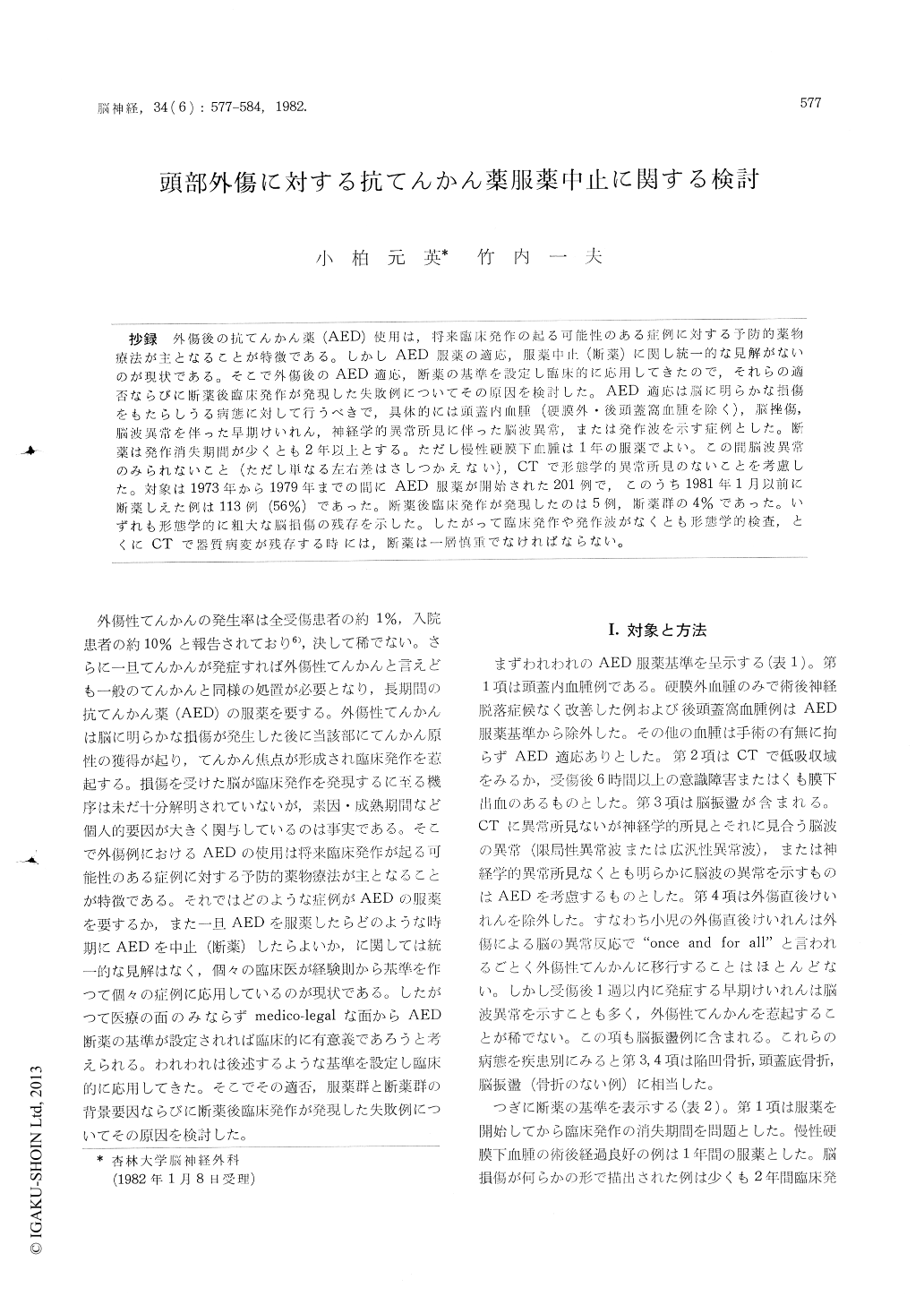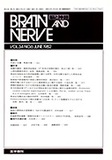Japanese
English
- 有料閲覧
- Abstract 文献概要
- 1ページ目 Look Inside
抄録 外傷後の抗てんかん薬(AED)使用は,将来臨床発作の起る可能性のある症例に対する予防的薬物療法が主となることが特徴である。しかしAED服薬の適応,服薬中止(断薬)に関し統一的な見解がないのが現状である。そこで外傷後のAED適応,断薬の基準を設定し臨床的に応用してきたので,それらの適否ならびに断薬後臨床発作が発現した失敗例についてその原因を検討した。AED適応は脳に明らかな損傷をもたらしうる病態に対して行うべきで,具体的には頭蓋事内血腫(硬膜外・後頭蓋窩血腫を除く),脳挫傷,脳波異常を伴った早期けいれん,神経学的異常所見に伴った脳波異常,または発作波を示す症例とした。断薬は発作消失期間が少くとも2年以上とする。ただし慢性硬膜下血腫は1年の服薬でよい。この間脳波異常のみられないこと(ただし単なる左右差はさしつかえない),CTで形態学的異常所見のないことを考慮した。対象は1973年から1979年までの間にAED服薬が開始された201例で,このうち1981年1月以前に断薬しえた例は113例(56%)であった。断薬後臨床発作が発現したのは5例,断薬群の4%であった。いずれも形態学的に粗大な脳損傷の残存を示した。したがって臨床発作や発作波がなくとも形態学的検査,とくにCTで器質病変が残存する時には,断薬は一層慎重でなければならない。
Traumatic epilepsy occurs with the formation of epileptic foci in the cerebral cortex after damage to cerebral tissue has been caused by a head injury. But the eliptogenic mechanism acquired by the cerebral cortex is not clearly understood. It may be that such personal characteristics as a predis-position toward epilepsy or the maturation period are contributing factors. The use of antiepileptic drugs (AED) for trauma patients is a form of pro-phylactic treatment in cases where there is the possibility of traumatic epilepsy. The question of which cases AED are indicated for, and when they should be withdrawn after administration has com-menced, is attended by many medical, social and psychological problems.
This study was undertaken not only to confirm the criteria for discontinuance of AED, but also to identify those factors causing epileptic seizures after discontinuance of AED.
Methods
AED administration was initiated between 1973 and 1979 for 201 patients with 1) intracranial hematoma other than epidural hematoma, 2) cere-bral contusion or an intracranial foreign body, 3) EEG abnormalities with of without abnormal neuro-logical signs, and 4) early traumatic epilepsy with EEG abnormalities. This administration of AED was discontinued for 113 (56%) of the 201 patients before January, 1981. The principles in this dis-continuance were as follow: 1) Freedom from seizures for one year in cases of chronic subdural hematoma, and for at least two years in cases of moderate or severe brain damage. 2) AED with-drawal was not attempted if EEGs taken during these periods definitely showed such abnormal findings as diffuse slow waves, focal slow waves or paroxysmal discharges; if underlying braindamage was either known to be present or conti-nued to be active, and if the recurrence of seizures would result in social difficulties.
In the discontinuance group of 113 patients, the mean seizure-free periods during AED treatment had been 2. 1 years. They were followed-up for periods ranging from six months to five years after AED withdrawal was initiated (mean 2. 6 years). Of the 113 patients, 108 (96%) remained free from seizures after AED withdrawal.
The recurrence of initial occurrence of seizures after AED withdrawal were noted in 5 patients, 4 with intracranial hematomas and 1 with cerebral contusion. These seizures commenced at from 7 months to 2 years after drug withdrawal. The 5patients were divided into two groups, the 1st group consisting of 3 patients who experienced their initial clinical seizures after drug withdrawal, and the 2nd group of 2 patients who had experi-enced clinical seizures prior to drug withdrawal but had shown no paroxysmal discharges in EEGs during medication. All 5 cases had demonstrated such abnormal CT findings as porencephaly, low density area, and asymmetry of ventricles which had disclosed the underlying morphological changes in cerebral tissure. Therefore, caution should be exercised not to withdraw AED in cases which show organic brain lesions after injury to the head.

Copyright © 1982, Igaku-Shoin Ltd. All rights reserved.


